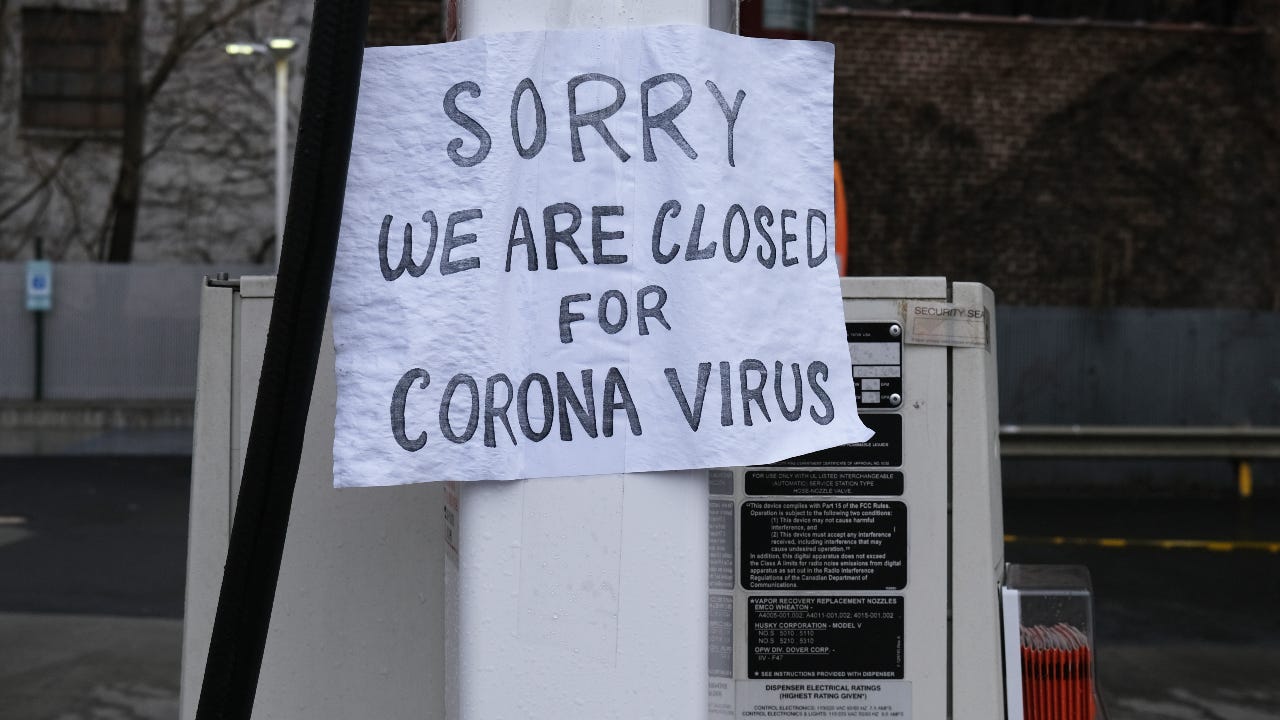Unemployment benefits and coronavirus: Here’s who qualifies and how to apply

Unemployment benefits will be a lifeline for the millions who’ve now lost their jobs due to the coronavirus crisis — but the system has never been the easiest to navigate.
From eligibility requirements to waiting periods, unemployment insurance (UI) applications come with several hoops and hurdles long before the checks get cut. And then the more immediate concern sinks in: How long will the benefits last?
Here’s how the U.S. unemployment insurance system works, including how to qualify and how to apply.
What is unemployment insurance?
Millions of Americans were living paycheck before the coronavirus came along. What happens when they face unexpected job loss? That’s where UI comes in.
The UI system is a joint federal-state program that provides aid to workers who’ve lost their job or a substantial portion of their income. The program is designed to help workers get through a temporary spell of joblessness, so they can still afford to pay bills and keep food on the table while they look for a new job.
Who qualifies for unemployment benefits?
An easy rule of thumb for UI eligibility is, if you’ve lost a substantial amount of income through no fault of your own, you could be eligible for UI. That’s because UI isn’t just reserved for individuals who involuntarily lost their jobs. Workers who have been furloughed but are still on their employers’ payrolls are eligible, as are those whose hours have been significantly reduced and those who’ve quit for fear of exposure to the virus.
Freelancers and other gig economy workers can also now apply, under the third fiscal care package. Those who are self-employed with a limited liability company or S corporation can also qualify. Typically, these workers are excluded.
But it still doesn’t apply to everyone. Individuals who are able to work from home with pay aren’t eligible for benefits, nor are those receiving paid leave from their employer, says Michele Evermore, senior policy analyst at the National Employment Law Project who specializes in unemployment insurance. Nor are those who’ve lost their job for a reason that’s their own fault, such as misconduct or negligence.
The Department of Labor released additional guidelines for states regarding who could qualify on March 12, in light of coronavirus-related shutdowns. States are allowed under federal law to provide UI benefits to workers who are employed by a firm that’s ceased operations due to the virus; to individuals who are quarantined but expected to return to work; and to individuals who leave their position due to risk of exposure to the virus.
Even if there’s just a small chance that you could qualify, still apply, and do it as soon as you can, Evermore says.
How to apply
That takes us to the most important step to receiving unemployment benefits: applying. It’s important to check your state’s website about area-specific requirements. Experts recommend applying as soon as you can, and in general, you’ll likely have to provide:
- Social security number
- Driver’s license
- Employer’s name, address, phone number
- Reason for leaving
- First and last day worked
- Home address and mailing address (if different)
- Telephone number and email address
- Bank name, address, routing and account numbers (for direct deposit)
Evermore also recommends gathering up all of your pay stubs, so you can provide additional documentation as needed. The information should show what you’ve made over a year-long period, and it can be used to prove how much income you were used to making.
All of this doesn’t mean it won’t be hard to get through. An unprecedented wave of applicants are overwhelming the system. More than 10 million individuals applied for UI benefits in March, and the uptick happened in a matter of days, when systems were still designed to support workers within the best labor market in decades.
Individuals filing for unemployment have confronted long wait times and, in the worst of circumstances, website crashes. Some states have even recommended that individuals apply on a certain day of the week based on their last name.
How much does UI offer, and how long will it last?
States are in charge of crafting their own criteria, deciding how much individuals get with each check and determining the duration of the program.
Most states offer at least 26 weeks of unemployment benefits, though it depends on where you live, according to the Center for Budget and Policy Priorities. Six states — Florida, North Carolina, Idaho, Kansas, Alabama and Georgia — have a sliding scale that adjusts depending on state unemployment. Meanwhile, Massachusetts and Montana offer a more generous 30 and 28 weeks, respectively, while Missouri offers only 13 weeks of benefits.
The program generally replaces half of the income individuals lost when they were laid off. Those weekly payouts as of April 2020 averaged to about $473 nationwide (which includes the District of Columbia) and ranged from as low as $235 in Mississippi to $823 in Massachusetts. Individuals with dependents are also often eligible for a higher amount. See what unemployment payouts total where you live.
States do have to follow federal guidelines, with the U.S. Department of Labor overseeing the entire system. (Every Thursday, the department releases weekly figures showing how many individuals have filed for claims, a closely watched indicator of health in both the labor market and broader economy).
During recessions and spells of elevated unemployment across the nation, the federal government has typically expanded benefits. Such was the case during the Great Recession — and it also came to fruition on March 27 when President Donald Trump signed a third coronavirus fiscal care package increasing benefits for up to four months and offering an additional $600 each week in benefits.
“We have historically argued that the replacement rate for UI benefits should be around 50 percent; that gives people enough money to keep going but doesn’t create the moral hazard that they’ll stay on unemployment as long as they can,” says Evermore. “But right now, no one can go out and find a new job. We’re all under quarantine.”
How long it takes to receive funds
Once you file, your state’s unemployment office will process your claim. Administrators verify your reason for unemployment with your previous employer and double check your documents.
The amount of time that processing takes depends on where you live. Illinois, for example, estimates three to 10 days for processing time. If you’re denied during this period, you should strongly consider applying again, Evermore says. In general, the Department of Labor estimates that it will take about two to three weeks before individuals start receiving their checks.
States also often have what’s called a “waiting week,” a timeframe before individuals start receiving their benefits. Some states are waiving those periods, including New York and Florida. That means individuals will get their funds sooner, Evermore says.
“It’s going to take state agencies some time to process claims, but once claims are approved, people will get benefits going back to the first week that they were unemployed, rather than skipping that week,” Evermore says. “It means more money as quickly as possible into the pockets of jobless workers.”
What to do after receiving funds
Most states require that unemployed individuals recertify on a regular basis. Washington state, for example, requires recipients submit a weekly claim after applying for unemployment to verify that their situation hasn’t changed.
Though it varies from state to state, you might need to prove that you’re willing to work and actively searching for work — though the latter requirement is changing in light of the coronavirus. At least 27 states have waived work-search requirements, from Arizona and California, to Ohio and North Carolina, according to NELP research. Other states, such as Alabama, have relaxed job search requirements so long as an unemployed individual takes “reasonable steps to preserve their ability to come back to that job.”
“It’s a really bad time to be out bothering employers for jobs,” Evermore says. “We want people to stay home.”
Do you have to pay the funds back later?
Don’t worry about having to pay back what you draw during your spell of unemployment.
The basic UI system is funded through payroll taxes, which are levies that employers have to pay on their employees. They exist at both the state and federal level, and are forward-funded, similar to the Social Security system. The federal government pays the administrative costs, though during periods of economic distress, it provides more funding to states for expanded benefits.
Also at the federal level is a way for states to borrow money in case state unemployment trust funds are depleted. Those rose to prominence during the Great Recession, Evermore says.
Bottom line
While states have moved to dramatically shore up funds and increase benefits, applying for the program shouldn’t be your only step if you’ve encountered unexpected job loss. It’s important to maintain your personal finances from two fronts — expenses and income — during job loss. Identify ways to cut back and use whatever savings you have to help cushion your wallet.
Still, it’s an unprecedented time for many Americans, given just how many have been abruptly put out of work.
Some economists say unemployment could soar to above 30 percent — more than during the Great Depression — but predicting the future isn’t easy. Some experts remain hopeful that, once the pandemic diminishes, Americans can transition back to work.
“More than any other economic data point, the unprecedented and massive level of more than 6.6 million new jobless claims captures the recent, heartbreaking financial devastation related to the coronavirus outbreak and measures aimed at containing it,” says Mark Hamrick, Bankrate’s senior economic analyst. “We hold onto the hope that many of these individuals will be able to return to their jobs once stay-at-home orders are lifted, consumers venture out and the peak in infection is behind us.”
Learn more:
- Stimulus checks: What consumers should consider doing with the money
- What to do if you can’t pay your loans during the coronavirus
- Avoid going overboard on cash withdrawals during coronavirus crisis
Why we ask for feedback Your feedback helps us improve our content and services. It takes less than a minute to complete.
Your responses are anonymous and will only be used for improving our website.






